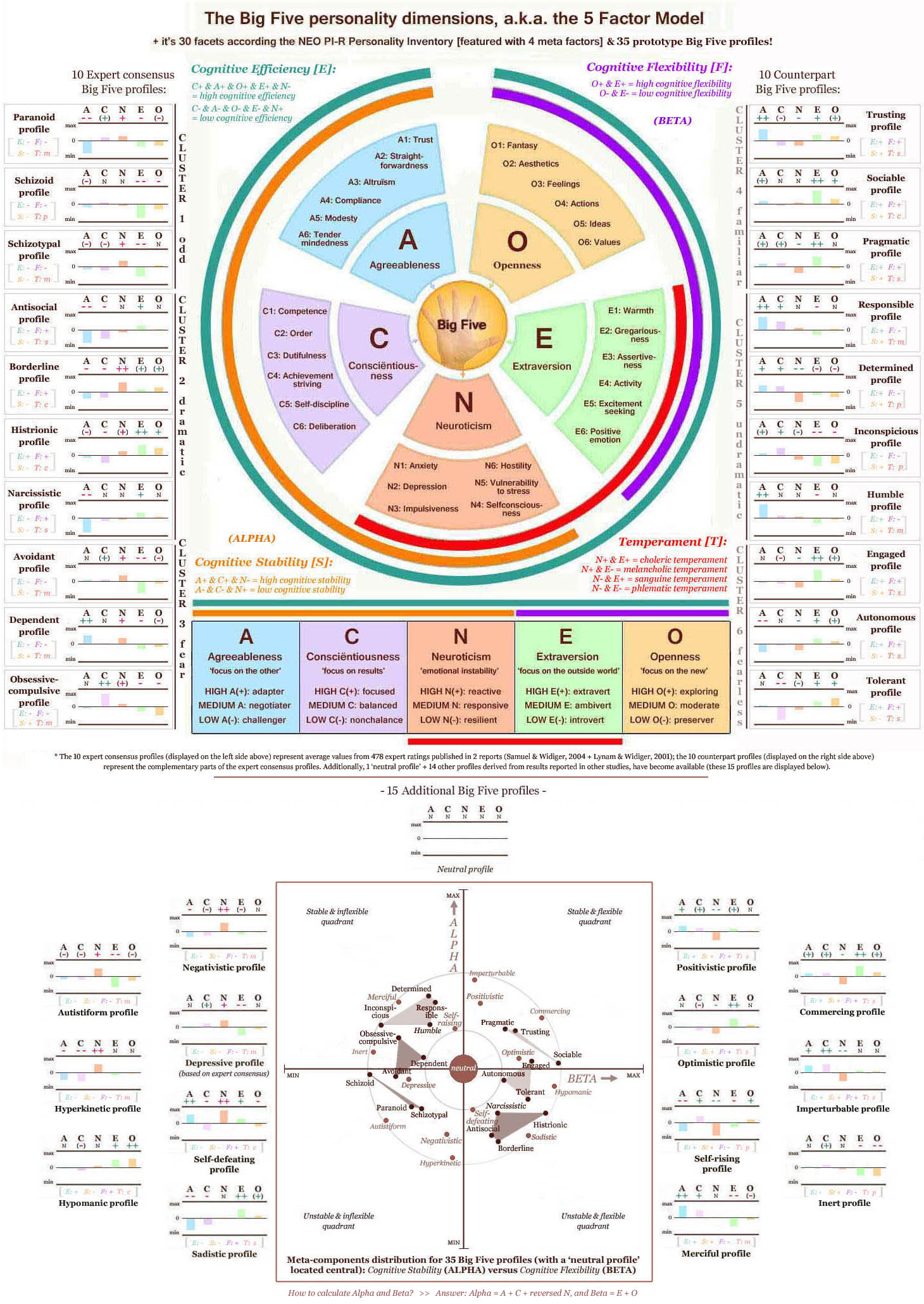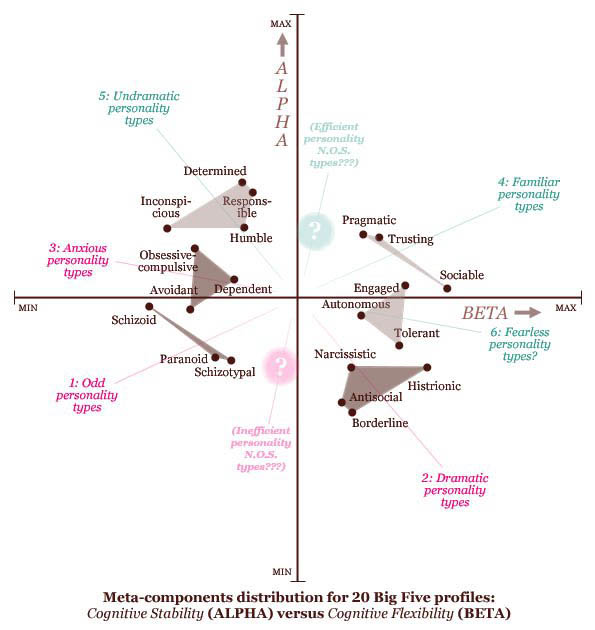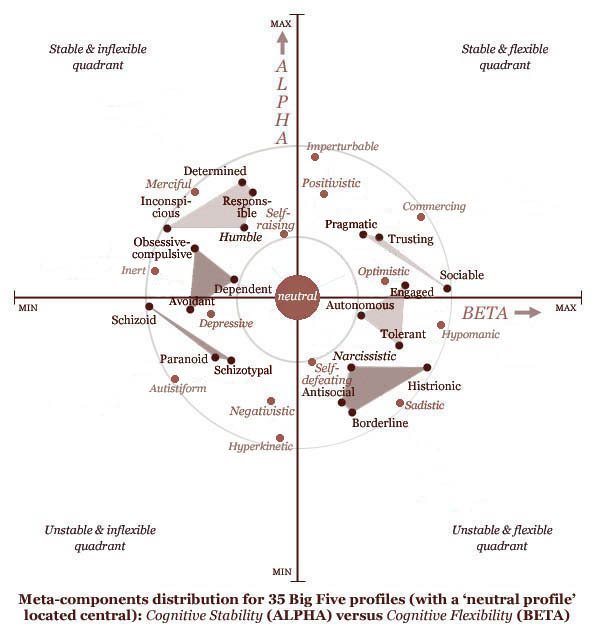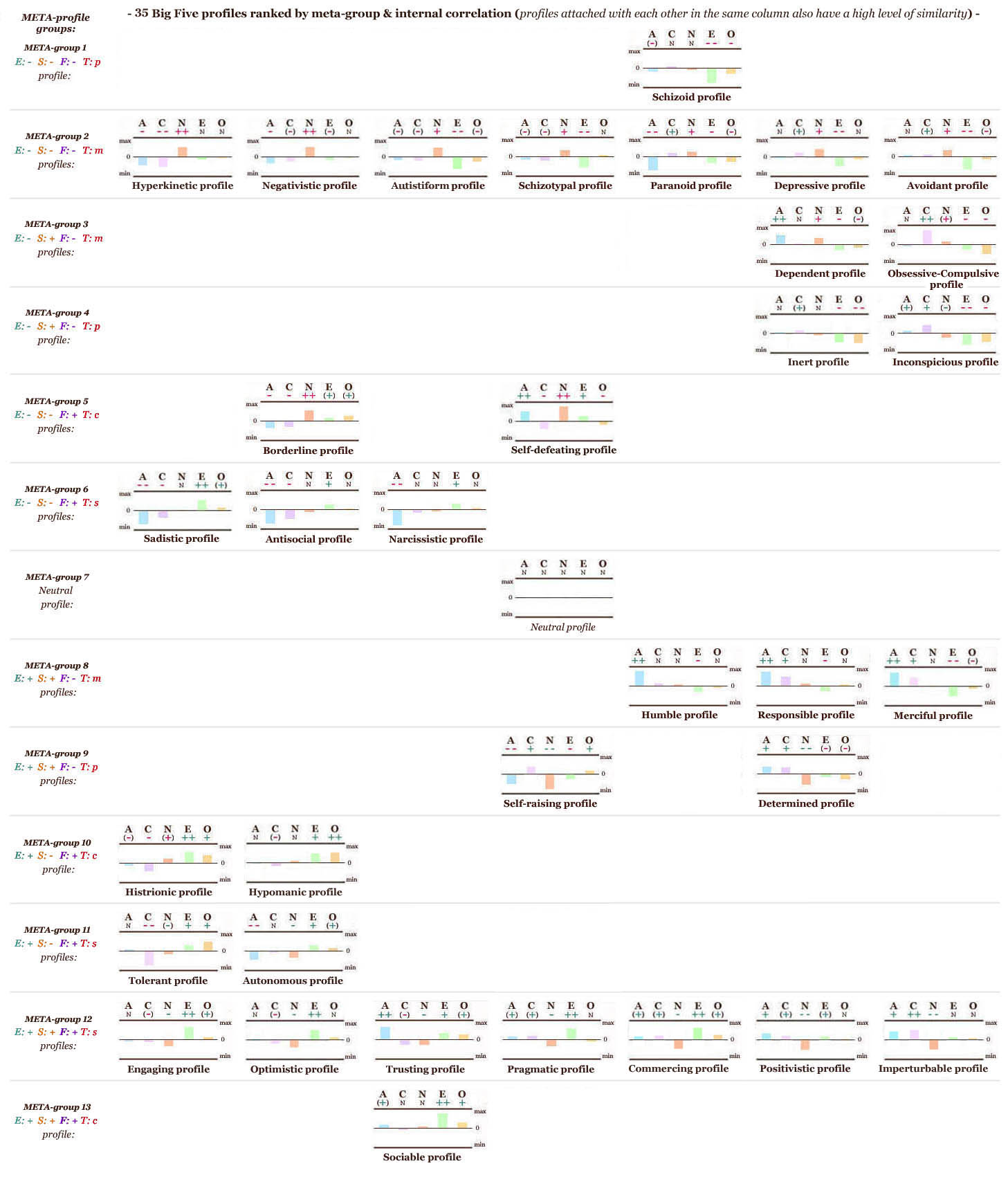
July 16, 2018
NOTICE: For this article a more comprehensive update (based on more precise data) is available here
How to interpret your Big Five (FFM) personality profile?
An innovative concept for the full Big Five personality spectrum of options derived from expert consensus ratings!
The Big Five personality spectrum presented below includes 35 prototype Big Five profiles:
10 profiles directly derived from experts consensus ratings (based on the 10 major personality disorders)
and their complemenatry 10 counterpart profiles, plus 15 additional profiles!

The Big Five personality model (a.k.a. Five-Factor Model, FFM) provides a framework to assess the core dynamics + higher-order structure of both normal and abnormal personality traits in an individual person. Even though the Big Five dimensions together present a profile representative for the individual, the overall assessment & interpretation of Big Five profiles has remained sort of an arbitrary challenge.
A structural strategy is presented here based on combining expert consensus ratings (associated with personality disorders) with a meta-component analysis. The core of the solution is summarized with an overview of the Big Five dimensions + it's 30 facets (each dimension has 6 facets), plus a description of the 4 so-called meta-components and 35 Big Five profile prototypes. An additional part of the solution involves the recommendation to assess two of the meta-components, by combining the 'cognitive stability' factor (ALFA) and the 'cognitive flexibility' factor (BETA).
NOTICE: The solution implicates that inversed Neuroticism values (= emotional stability) are used in the calculation of 'cognitive stability' and for 'cognitive efficiency'; this explains why the profiles show red color for positive Neuroticism values and green color for negative Neuroticism values.
The left column of the picture displayed at the top of this article, presents 10 expert consensus Big Five profiles which are based on prototype behavior patterns associated with the 10 personality disorders (representing average values of 2 studies: Lynam & Widiger, 2001: table 1 & Samuel & Widiger, 2004: table 1). And the right column presents 10 counterpart Big Five profiles, which represent the 'opposite' behavior patterns of the 10 expert consensus Big Five profiles.

The picture on the right displays the distribution of two meta-components (cognitive stability & cognitive stability) for these 20 Big Five profiles, which shows that all are located at a considerable distance from a neutral center. This center sort of represents sort a 'neutral' constellation (sort of, because this can even apply to profiles with the most extreme values on multiple Big Five dimensions; theoretically these can become neutralized at the level of the meta factors!!!).
Curiously, the picture shows that none of the 20 profiles are located near the vertical axis. Which raised the question whether there are other personality disorder related behavior styles can typically be found there. Wikipedia presents a list of 6 alternative personality disorder variants - which have been considered in the past for inclusion in the DSM & ICD diagnostic systems (but were not included, proboably due to e.g. lack of consensus).
For 4 out of 6 of these alternative personality variants Wikipedia does present a table listing a general overview of tendencies on Big Five facet level; however, expert consensus ratings are available only for the 'depressive' variant. For the other 3 variants estimates have been made based on the Wikipedia table combined with the 2 expert consensus studies; however, for the 'self-defeating' variant the estimate is also based on correlation results with other personality variants and for the 'negativistic' variant the estimate is also based on results reported in for the Big Five dimensions in 3 studies (2017, 2009 & 1989).
Finally, also 3 other alternative protype Big Five profiles have been added refering to in respective: autistiform behavior [ASD] (derived from data involving 6 studies), hyperkinetic behavior [ADHD] (derived from data involving 3 studies) & hypomanic behavior (derived from data involving 2 studies).
When all 7 alternative profiles + their 7 counterpart profiles are also included in the meta-component overview the result is quite astonishing.

The picture on the left shows that most of the 7 alternative Big Five profiles are located in or near the lower empty zones of the picture above. Also, the others (depressive vs. optimistic and sadistic vs. merciful) are located outside but near the cluster-zones where they appear to fit well - all are located at a considerable distance from the 'neutral' zone. The result shows now a closed ring with 34 Big Five prototype profiles included (+ the neutral profile located in the center of the ring).
Next to the picture with 35 Big Five profiles featured at the top of this article, the box describing the meta-components provides an additional tool to (pre-)select the profiles which are most likely to resemble the Big Five profile for any individual.
A recommendation for assessment purposes:
In order to match an individual profile with one of the 35 Big Five profiles, it would be best to find the profile that has the overall smallest square-distance based on all Big Five dimensions plus the ALFA & BETA meta-components summarized. The meta-component chart can be used to reduce the task by focusing on the most near profile(s) inside the as follows: the most near profile with a "perfect match" (in terms of the direction of the Big Five scores) with at least one of both (ALPHA or BETA) meta-components is likely to represent the best-matching-profile. Optionally, it might also be interesting to take a look at which profile follows next, etc.
Finally, how to calculate Alpha and Beta?
Answer: Alpha = A + C + reversed N, and Beta = E + O
NOTICE: Recent studies have revealed that best results are likely produced when the Big Five dimensions are included with unequal weight in the ALPHA & BETA meta-components; a recent meta-study (van der Linden, 2016) suggests that the weight-differences are likely small: Neuroticism is most likely to have extra weight, and Agreeableness and Openness are most likely to have less weight. However, the details appear not definite yet after earlier studies have suggested that especially Openness is by far most likely to have the smallest weight; for this reason the use of weights has been avoided in the present article (though the impact would have been small if weights had been used based on the 2016 meta-study).
Meanwhile, the Five-Factor model sort of became included in the personality disorder section of both the DSM 5 and ICD 11 classification systems. The table below describes the parallels (featured with average weight estimates derived from correlation sizes reported in four Big Five meta-component studies.

Recommended (free) online opportunities for Big Five personality profile assessment:
• 123Test Big Five trait assessment (120 items)
• PersonalityAsseccor IPIP Big Five tests: (a) 300 items - (b) 120 items - (c) 44 items
• Quick Personality Test - Big Five (10 items)
The continuation of this article presents a description for each of the 35 Big Five profiles e.g. featured with a measure for Cognitive Efficiency, which is a.k.a. the 'General Factor of Personality' [GFP] - during the past decade this concept became also associated with 'emotional intelligence' (EQ).

- Summary description for each of the 29 Big Five personality profiles -
{~ Prevalence estimates are based on 362 subjects: 262 Dutch subjects (77 males & 185 females) who performed the NEO PI-R questionnaire
+ 100 international celebs (78 males & 22 females) who's Big Five profile is featured at IDRlabs.com}
>> CLUSTER 1:
• Paranoid personality profile {~ 4,42%}:
paranoia, suspiciousness and generalized mistrust of others | CODE: A-- with E- N+ (O-) (C+)
Big Five dimensions: Agreeableness -58.2%, Conscientiousness +20.9%, Neuroticism +26.9%, Extraversion -34.8%, Openness -23.5%;
META components: Cognitive efficiency -24.5%, ALPHA -21.4%, BETA -29.1%, Melancholic temperament
• Schizoid personality profile {~ 1,65%}:
lack of interest in social relationships, solitary lifestyle without intimate attachments | CODE: E-- with O- (A-), normal N C
Big Five dimensions: Agreeableness -18.9%, Conscientiousness +2.3%, Neuroticism -7.1%, Extraversion -77.3%, Openness -27.5%;
META components: Cognitive efficiency -22.9%, ALPHA -3.2%, BETA -52.4%, Phlegmatic temperament
• Schizotypal personality profile {~ 3,59%}:
unconventional beliefs featured by social anxiety with paranoid ideation | CODE: E-- with N+ (C-) (A-), normal O
Big Five dimensions: Agreeableness -15.7%, Conscientiousness -19.0%, Neuroticism +31.4%, Extraversion -54.7%, Openness +8.3%;
META components: Cognitive efficiency -22.5%, ALPHA -22.0%, BETA -23.2%, Melancholic temperament
>> CLUSTER 2:
• Antisocial personality profile {~ 0,55%}:
disregard for the rights of others with a low moral sense or conscience | CODE: A-- with C- E+, normal N O
Big Five dimensions: Agreeableness -72.7%, Conscientiousness -48.4%, Neuroticism -11.1%, Extraversion +27.3%, Openness +4.4%;
META components: Cognitive efficiency -15.7%, ALPHA -36.7%, BETA +15.9%, Sanguine temperament
• Borderline personality profile {~ 1,93%}:
intense unstable relationships with other people | CODE: N++ with A- C- (O-) (E+)
Big Five dimensions: Agreeableness -36.8%, Conscientiousness -31.0%, Neuroticism +53.8%, Extraversion +14.7%, Openness +24.4%;
META components: Cognitive efficiency -16.5%, ALPHA -40.5%, BETA +19.5%, Choleric temperament
• Histrionic personality profile {~ 2,76%}:
pattern of attention-seeking emotions | CODE: E++ with O+ C- N+ (A-)
Big Five dimensions: Agreeableness -13.6%, Conscientiousness -38.5%, Neuroticism +21.7%, Extraversion +51.4%, Openness +39.5%;
META components: Cognitive efficiency +3.4%, ALPHA -24.6%, BETA +45.4%, Choleric temperament
• Narcissistic personality profile {~ 1,38%}:
exaggerated feelings of self-importance with need for admiration; lack of empathy | CODE: A-- with E+, normal C N O
Big Five dimensions: Agreeableness -72.1%, Conscientiousness -11.6%, Neuroticism -9.2%, Extraversion +28.4%, Openness +8.5%;
META components: Cognitive efficiency -7.5%, ALPHA -24.8%, BETA +18.5%, Sanguine temperament
>> CLUSTER 3:
• Avoidant personality profile {~ 1,66%}:
social anxiety with feelings of inadequacy, despite a strong desire for intimacy | CODE: E-- with N+ (O-) (C+), normal A
Big Five dimensions: Agreeableness +7.4%, Conscientiousness +12.0%, Neuroticism +32.4%, Extraversion -64.1%, Openness -12.1%;
META components: Cognitive efficiency -17.8%, ALPHA -4.3%, BETA -38.1%, Melancholic temperament
• Dependent personality profile {~ 1,66%}:
psychological depending on others to meet own emotional and physical needs | CODE: A++ with N+ E- (O-), normal C
Big Five dimensions: Agreeableness +47.5%, Conscientiousness +6.3%, Neuroticism +34.0%, Extraversion -30.5%, Openness -13.7%;
META components: Cognitive efficiency -4.9%, ALPHA +6.6%, BETA -22.05%, Melancholic temperament
• Obsessive-Compulsive personality profile {~ 2,76%}:
inefficient pattern of concern with orderliness & details, at the expense of openness to experience & flexibility | CODE: C++ with O- E- (N+), normal A
Big Five dimensions: Agreeableness -5.9%, Conscientiousness +70,9%, Neuroticism +13.1%, Extraversion -26.1%, Openness -46.3%;
META components: Cognitive efficiency -4.1%, ALPHA +17.3%, BETA -36.2%, Melancholic temperament
>> CLUSTER 4 (these represent the inversed profiles of CLUSTER 1):
• Trusting personality profile {~ 4,97%}:
credulity, unsuspiciousness and generalized trust of others | CODE: A++ with E+ N- (O+) (C-)
Big Five dimensions: Agreeableness +58.2%, Conscientiousness -20.9%, Neuroticism -26.9%, Extraversion +34.8%, Openness +23.5%;
META components: Cognitive efficiency +24.5%, ALPHA +21.4%, BETA +29.1%, Sanguine temperament
• Sociable personality profile {~ 3,59%}:
high interest in social relationships, pro social lifestyle & benevolent towards intimate attachments | CODE: E++ with O+ (A+), normal N C
Big Five dimensions: Agreeableness +18.9%, Conscientiousness -2.3%, Neuroticism +7.1%, Extraversion +77.3%, Openness +27.5%;
META components: Cognitive efficiency +22.9%, ALPHA +3.2%, BETA +52.4%, Choleric temperament
• Pragmatic personality profile {~ 2,21%}:
conventional beliefs featured by social confidence with sane ideation | CODE: E++ with N- (C+) (A+), normal O
Big Five dimensions: Agreeableness +15.7%, Conscientiousness +19.0%, Neuroticism -31.4%, Extraversion +54.7%, Openness -8.3%;
META components: Cognitive efficiency +22.5%, ALPHA +22.0%, BETA +23.2%, Sanguine temperament
>> CLUSTER 5 (these represent the inversed profiles of CLUSTER 2):
• Responsible personality profile {~ 1,93%}:
respecting the rights of others with a high moral sense and/or conscience | CODE: A++ with C+ E-, normal N O
Big Five dimensions: Agreeableness +72.7%, Conscientiousness +48.4%, Neuroticism +11.1%, Extraversion -27.3%, Openness -4.4%;
META components: Cognitive efficiency +15.7%, ALPHA +36.7%, BETA -15.9%, Melancholic temperament
• Determined personality profile {~ 4,42%}:
calm, stable relationships with society & other people | CODE: N-- with A+ C+ (O+) (E-)
Big Five dimensions: Agreeableness +36.8%, Conscientiousness +31.0%, Neuroticism -53.8%, Extraversion -14.7%, Openness -24.4%;
META components: Cognitive efficiency +16.5%, ALPHA +40.5%, BETA -19.5%, Phlegmatic temperament
• Inconspicious personality profile {~ 1,93%}:
moderate behavior, emotions are expressed in privacy | CODE: E-- with O- C+ N- (A+)
Big Five dimensions: Agreeableness +13.6%, Conscientiousness +38.5%, Neuroticism -21.7%, Extraversion -51.4%, Openness -39.5%;
META components: Cognitive efficiency -3.4%, ALPHA +24.6%, BETA -45.4%, Phlegmatic temperament
• Humble personality profile {~ 0,83%}:
modest feelings of self-importance without need for admiration, combined with high empathy | CODE: A++ with E-, normal C N O
Big Five dimensions: Agreeableness +72.1%, Conscientiousness +11.6%, Neuroticism +9.2%, Extraversion -28.4%, Openness -8.5%;
META components: Cognitive efficiency +7.5%, ALPHA +24.8%, BETA -18.5%, Melancholic temperament
>> CLUSTER 6 (these represent the inversed profiles of CLUSTER 3):
• Engaged personality profile {~ 0,55%}:
social bravery, without feelings of inadequacy regarding needs for intimacy | CODE: E++ with N- (O+) (C-), normal A
Big Five dimensions: Agreeableness -7.4%, Conscientiousness -12.0%, Neuroticism -32.4%, Extraversion +64.1%, Openness +12.1%;
META components: Cognitive efficiency +17.8%, ALPHA +4.3%, BETA +38.1%, Sanguine temperament
• Autonomous personality profile {~ 2,49%}:
psychologically independent of others to fulfill their own emotional and physical needs | CODE: A++ with N+ E- (O-), normal C
Big Five dimensions: Agreeableness -47.5%, Conscientiousness -6.3%, Neuroticism -34.0%, Extraversion +30.5%, Openness )13.7%;
META components: Cognitive efficiency +4.9%, ALPHA -6.6%, BETA +22.05%, Sanguine temperament
• Tolerant personality profile {~ 3,31%}:
efficient interest in orderliness & details, above average openness to experience & flexibility | CODE: C++ with O- E- (N+), normal A
Big Five dimensions: Agreeableness +5.9%, Conscientiousness -70,9%, Neuroticism -13.1%, Extraversion +26.1%, Openness +46.3%;
META components: Cognitive efficiency +4.1%, ALPHA -17.3%, BETA +36.2%, Sanguine temperament
>> 15 ADDITIONAL BIG FIVE PROFILES:
• Autistic personality profile {~ 4,42%}:
difficulties in establishing and maintaining relationships & conversations, unusual behaviors | CODE: E-- with N+ (O-) (C-) (A-)
Big Five dimensions: Agreeableness -17.7%, Conscientiousness -21.2%, Neuroticism +48.2%, Extraversion -62.3%, Openness -24.5%;
META components: Cognitive efficiency -34.8%, ALPHA -29.0%, BETA -43.4%, Melancholic temperament
• Hyperkinetic personality profile {~ 5,25%}:
low self-directedness, inattentive behavior and/or hyperactive behavior | CODE: C-- & N++ with A-, normal E & O
Big Five dimensions: Agreeableness -43.3%, Conscientiousness -52.2%, Neuroticism +51.8%, Extraversion -11.2%, Openness -5.6%;
META components: Cognitive efficiency -32.8%, ALPHA -49.1%, BETA -8.4%, Melancholic temperament
• Hypomanic personality profile {~ 3,04%}:
high energy: disinhibited & elevated behavior, combined with high levels of euphoria or irritation | CODE: O++ with E+ (C-), normal N & A
Big Five dimensions: Agreeableness -2.2%, Conscientiousness -16.5%, Neuroticism +9.9%, Extraversion +48.4%, Openness +52.8%;
META components: Cognitive efficiency +14.5%, ALPHA -9.5%, BETA +50.6%, Choleric temperament
• Negativistic personality profile {~ 2,21%}:
passive-aggressive attitudes + passive resistance to demands manifesting in social & occupational situations | CODE: N++ with A- (C-) (E-), normal O
Big Five dimensions: Agreeableness -34.0%, Conscientiousness -23.2%, Neuroticism +52.1%, Extraversion -16.2%, Openness -2.7%;
META components: Cognitive efficiency -25.6%, ALPHA -36.4%, BETA -9.5%, Melancholic temperament
• Depressive personality profile {~ 1,10%}:
pattern of depressive cognitions and behaviors, pessimistic perceptions involving self-concept & mood | CODE: E-- with N+ (C+), normal O A
Big Five dimensions: Agreeableness +4.0%, Conscientiousness +19.7%, Neuroticism +39.8%, Extraversion -50.0%, Openness -11.9%;
META components: Cognitive efficiency -15.6%, ALPHA -5.4%, BETA -31.0%, Melancholic temperament
• Self-defeating personality profile {~ 2,21%}:
self-defeating behavior, undermining of pleasurable experiences and rejection of help offered by others | CODE: N++ A++ with C- E+ (O-)
Big Five dimensions: Agreeableness +52.9%, Conscientiousness -40.0%, Neuroticism +80.0%, Extraversion +26.1%, Openness -16.3%;
META components: Cognitive efficiency -11.5%, ALPHA -22.4%, BETA +4.9%, Choleric temperament
• Sadistic personality profile {~ 2,21%}:
deliberate cruelty, either mental or physical, to other people, (or to animals) | CODE: A-- E++ with C- (O+) normal N
Big Five dimensions: Agreeableness -72.4%, Conscientiousness -38.5%, Neuroticism 0%, Extraversion +57.8%, Openness +14.1%;
META components: Cognitive efficiency -7.8%, ALPHA -37.0%, BETA +36.0%, Sanguine temperament
• Neutral personality profile {~ 4,42%}:
(any description would not be appropriate here) | CODE: normal A C N E O
Big Five dimensions: Agreeableness 0%, Conscientiousness 0%, Neuroticism 0%, Extraversion 0%, Openness 0%;
META components: Cognitive efficiency 0%, ALPHA 0%, BETA 0%, neutral temperament
• Merciful personality profile {~ 2,49%}:
humane gentleness, either mental or physical, to other people, (or to animals) | CODE: A++ E-- with C+ (O-) normal N
Big Five dimensions: Agreeableness +72.4%, Conscientiousness +38.5%, Neuroticism 0%, Extraversion -57.8%, Openness -14.1%;
META components: Cognitive efficiency +7.8%, ALPHA +37.0%, BETA -36.0%, Melancholic temperament
• Self-raising personality profile {~ 1,10%}:
self-raising behavior, cherishing pleasurable experiences and accepting of help offered by others | CODE: N-- A-- with C+ E- (O+)
Big Five dimensions: Agreeableness -52.9%, Conscientiousness +40.0%, Neuroticism -80.0%, Extraversion -26.1%, Openness +16.3%;
META components: Cognitive efficiency +11.5%, ALPHA +22.4%, BETA -4.9%, Phlegmatic temperament
• Optimistic personality profile {~ 2,21%}:
pattern of optimistic cognitions and behaviors, positive perceptions involving self-concept & mood | CODE: E++ with N- (C-), normal O A
Big Five dimensions: Agreeableness -4.0%, Conscientiousness +19.7%, Neuroticism -39.8%, Extraversion +50.0%, Openness +11.9%;
META components: Cognitive efficiency +15.6%, ALPHA +5.4%, BETA -31.0%, Sanguine temperament
• Positivistic personality profile {~ 2,49%}:
active-positive attitudes + active aiding to demands manifesting in social & occupational situations | CODE: N-- with A+ (C+) (E+), normal O
Big Five dimensions: Agreeableness +34.0%, Conscientiousness +23.2%, Neuroticism -52.1%, Extraversion +16.2%, Openness +2.7%;
META components: Cognitive efficiency +25.6%, ALPHA +36.4%, BETA +9.5%, Sanguine temperament
• Inert personality profile {~ 3,59%}:
high energy: disinhibited & elevated behavior, combined with high levels of euphoria or irritation | CODE: O++ with E+ (C-), normal N & A
Big Five dimensions: Agreeableness +2.2%, Conscientiousness +16.5%, Neuroticism -9.9%, Extraversion -48.4%, Openness -52.8%;
META components: Cognitive efficiency -14.5%, ALPHA +9.5%, BETA -50.6%, Choleric temperament
• Imperturbable personality profile {~ 6,63%}:
high self-directedness, attentive behavior and/or inactive behavior | CODE: C++ & N-- with A+, normal E & O
Big Five dimensions: Agreeableness +43.3%, Conscientiousness +52.2%, Neuroticism -51.8%, Extraversion +11.2%, Openness +5.6%;
META components: Cognitive efficiency +32.9%, ALPHA +49.1%, BETA +8.4%, Sanguine temperament
• Commercing personality profile {~ 8,01%}:
skills for establishing and maintaining conversations & relationships, effective behaviors | CODE: E++ with N- (O+) (C+) (A+)
Big Five dimensions: Agreeableness +17.7%, Conscientiousness +21.2%, Neuroticism -48.2%, Extraversion +62.3%, Openness +24.5%;
META components: Cognitive efficiency +34.8%, ALPHA +29.0%, BETA +43.4%, Sanguine temperament
NOTICE: For this article a more comprehensive update (based on more precise data) is available here

FINAL NOTIFICATION:
In the near future the method described above will be used to find out whether
certain hand signs (such as for example the simian line) are more likely to match with certain personality profile structures, etc.